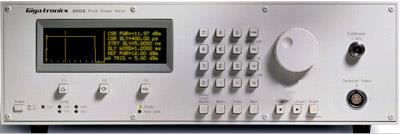
|
|
The Giga-tronics 8501A Single Channel Peak Power Meter combines CW power measurement with the ability to make precise peak power measurements at any point on a pulsed waveform. This dual, built-in capability lets you measure and analyze pulsed waveforms with a single instrument. A reference cursor pinpoints the precise measurement location on the waveform with 100 ps resolution. Precise sequential sampling lets you measure the same point on each pulse at over 70 measurements per second. The Giga-tronics 8501A uses high-speed diode sensors, rather than slower thermal sensors, to achieve higher sampling rates. Interchangeable sensors cover the frequency range from 30 MHz to 40 GHz. Fast rise time sensors are available to measure single shot or repetitive pulses as narrow as 15 ns. And the same sensors measure CW signals over a wide -40 to +20 dBm dynamic range.
Specifications.
Frequency Range: 30 MHz to 40 GHz depending on sensors (see sensors specifications).
Power Range:
Pulse: -20 to +20 dBm.
CW: -40 to +20 dBm (see sensor specifications).
Time Base Range: 1.2 ns/div to 20 ms/div (12 ns to 200 ms time window, using either the Data Entry Keyboard or the Control Knob).
Maximum Resolution: 0.1 ns.
Accuracy: 0.01% of time window, ± 1 ns.
Triggering Modes:
Internal: -20 to + 16 dBm
External (BNC): TTL Levels, Maximum PRF 1 MHz
Trigger Delay Range: 0 to 200 ms, using either the Data Entry Keyboard or the Control Knob.
Resolution: 0.1 ns
Accuracy: 0.01% of delay, ± 1 ns
Minimum Pulse Width: 20 ns, 15 ns rise time sensors
Markers: Up to 4 markers per channel plus a Reference Power Level cursor. Markers can be positioned at any point on the pulse waveform. Typically they would be positioned to make rise time and pulse width measurements. The markers and cursor can be positioned either at user selected delays or automatically at specified percentage of amplitude for pulse parameter measurements.
Graph Display Mode: Plots the outline of the detected pulse on the front panel display, and provides readout of amplitude and timing information.
Fast Measurement Mode: Available under GPIB control to provide fast data acquisition and output. For an average number = 1, typically between 70 and 120 measurements per second are made. Via the rear panel analog output, swept frequency response tests can be made using a network analyzer.
CALIBRATOR
Frequency: 1 GHz ± 5%.
Power Uncertainty at 1 mW: ± 1.5%.
Return Loss at 1 mW: >25 dB.
Self Calibration Time: <1 minute.
Connector: Type N(f).
|